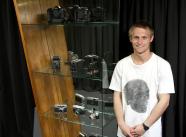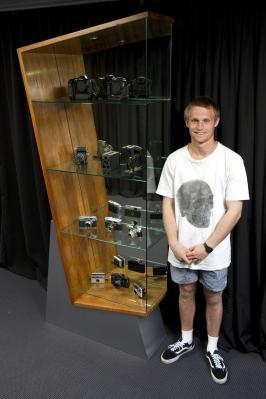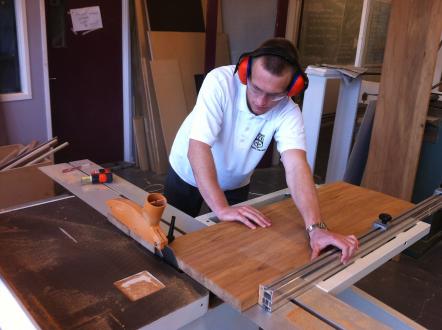Year 13 student outcome: Photography cabinet
This resource gives an example of a stellar student outcome and describes key aspects of the project and assessment opportunities.
Logan's outcome | Modelling and resourcing | Fitness for purpose | Assessment opportunities
Logan’s outcome
In year 13 students find their own context and issue for their technology projects.
My client is a very keen photographer and needs a suitable cabinet in order to effectively display and protect all his old camera gear. The budget is quite limited for such a large piece of furniture. However, I have well developed skills in working with wood, and with the right selection of materials this can be done. The storage cabinet needs to fit the space and the materials used. The overall effect should be aesthetically pleasing, include LED lighting, and display the cameras effectively. The client was also keen to have something unique – that’s not seen in stores.
Logan West
Modelling and resourcing
- Logan photographed and measured the intended environment.
- To help find an outcome that would suit the client, Logan asked for feedback on existing solutions and used pencil sketches and SketchUp to show ideas.
- He created a 1:10 sale model out of MDF and Perspex to test his final ideas.
- Logan consulted Gateway Glass and Aluminium Ltd (Thames) for advice on the glass and the associated jointing methods. They cut the glass pieces to specifications Logan provided. He used 6 mm toughened clear glass for the shelves.
- Logan used a 5 mm vinyl-backed mirror for safety if the mirror broke.
- The heart rimu in the cabinet had been donated to the school from a local iwi.
- The rimu was biscuit jointed.
- The rimu was finished with polyurethane finish (three coats) and waxed with Briwax. UV bond glass glue was selected for the glass joints because it was quick drying.
- The base was made from MDF and covered with a brushed aluminium laminate.
- Laser Electrical (Ngatea) were consulted for advice on the LED lighting system and the best method for its installation.
- The light was a tilting aluminium downlight powered by a 60W 12V LED power supply hidden in the base of the cabinet.
Fitness for purpose in its broadest sense – some points to note
-
Technical acceptability
Logan ensured the outcome followed technically acceptable practices through consultation with local businesses, advice from a teacher who is a furniture-maker, and extensive testing of finishes, materials, and jointing methods. -
Sustainability of resources
The formica aluminium laminate on the base will not scuff or easily mark so it should last. The aluminium laminate was made from recycled aluminium. The rimu was donated by a local iwi who replace harvested natives. -
Social acceptability
The client (a teenage boy) was extremely pleased with his outcome. In addition to providing him with secure storage for his camera collection, it fitted into and added to the aesthetics of his bedroom.



